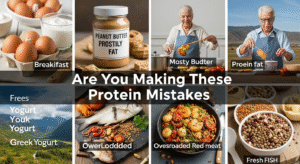Getting enough protein is essential for energy, muscle strength, and even your immune system—but it’s not just about the amount. When you eat protein and where it comes from are just as important. Many people also underestimate how much protein their body needs, especially as they age or become more active.
Protein supports muscles, organs, skin, metabolism, and appetite control. While our bodies can create some amino acids, others must come directly from food. Unlike fats or carbs, our bodies don’t store protein, meaning we must get enough daily to avoid losing muscle mass.
“If you’re not getting enough protein for a long time, your body will break down muscle to make up for it,” says Anne Kozil, a registered dietitian at Colorado State University.
To help you avoid common pitfalls, here are six frequent mistakes people make with their protein intake—and what to do instead.
1. Skipping Protein at Breakfast
If you’re loading up on protein only at dinner, you’re not alone. Many people start their day with low-protein breakfasts like cereal, toast, or pastries and only get serious about protein in the evening.
But that’s not ideal. Studies show that high-protein breakfasts improve satiety and help manage cravings throughout the day. Without enough morning protein, you’re more likely to snack on sweets or reach for processed snacks by mid-morning.
Kozil often hears clients say, “I can’t stop snacking,” or “I crave sugar all day.” When they boost their protein intake at breakfast, these cravings tend to drop significantly.

What to Do:
Aim for 25–30 grams of protein in the morning. Good options include:
- Eggs or egg-based burritos
- Greek yogurt topped with seeds, nuts, and berries
- Smoothies with protein powder (whey, pea, or soy)
- Cottage cheese or hard-boiled eggs
These options stabilize blood sugar and keep hunger at bay, helping you make healthier food choices throughout the day.
2. Relying on Peanut Butter as a Main Protein Source
Peanut butter may be marketed as “protein-packed,” but it’s mostly fat, not protein. A single serving (2 tablespoons) contains around 7 grams of protein, but also 16 grams of fat and nearly 200 calories.
That’s why experts like Jose Antonio, a professor of health and performance, say it’s better to think of peanut butter as a healthy fat, not a primary protein source.
Sure, it offers fiber, vitamins, and unsaturated fats. But if you’re counting on it for your daily protein, you may be consuming more calories than needed—and possibly gaining unwanted weight.

What to Do:
Enjoy peanut butter in moderation, but get your protein from:
- Eggs
- Lean chicken or turkey
- Fish
- Beans
- Low-fat dairy
Use peanut butter as a complement, not your main source of protein.
3. Not Adjusting Protein Intake With Age
As we grow older, muscle mass naturally decreases, especially after age 60. On top of that, the body becomes less responsive to protein, making it harder to maintain or build muscle—a condition known as anabolic resistance.
Katie Dodd, a geriatric dietitian, explains, “Muscle is vital for everyday activities—from walking to brushing your teeth. As you age, protecting what you have becomes even more important.”
While the baseline recommendation is 0.36 grams of protein per pound, older adults may need 0.45 to 0.54 grams per pound to support muscle and prevent frailty.

What to Do:
If you’re 65 or older and weigh 150 pounds, aim for 68–81 grams of protein per day. Spread this across all meals to maximize muscle retention and recovery.
Sources like fish, eggs, legumes, and lean meats can help older adults maintain independence and physical strength longer.
4. Eating Too Much Red and Processed Meat
Red meats like beef and pork are high in protein, but also in saturated fat, which can raise “bad” LDL cholesterol and increase the risk of heart disease. Processed meats like bacon, sausages, and deli slices also come with added sodium and preservatives, which have been linked to cancer risks, particularly colorectal cancer.
According to the American Institute for Cancer Research, limit red meat to no more than 12 to 18 ounces per week, and keep processed meat consumption to a minimum—ideally none at all.

What to Do:
Balance your diet by incorporating:
- Poultry
- Seafood
- Legumes
- Tofu and tempeh
- Eggs
Protein variety is key to getting nutrients without the health risks.
5. Not Eating Enough Fish
Seafood is one of the healthiest protein-rich foods available. A small portion of salmon (3.5 ounces) delivers over 22 grams of protein and plenty of omega-3 fatty acids, which are essential for brain and heart health.
Yet 9 out of 10 adults don’t eat enough fish, missing out on benefits like improved brain function and lower mortality risk. Research shows that eating even two ounces of fish per day can reduce early death risk by 12%.

What to Do:
Add at least two seafood meals per week with options like:
- Wild salmon
- Sardines or anchovies
- Atlantic mackerel
- Rainbow trout
- Oysters and mussels
Try grilling, baking, or steaming fish for a healthy protein boost that supports long-term wellness.
6. Overlooking Protein-Rich Plant Foods
Beans, lentils, peas, and other pulses are often ignored despite being nutritional powerhouses. They offer not just protein, but also fiber, iron, magnesium, and other vital nutrients. A single cup of cooked lentils or black beans can give you 15–18 grams of protein and more than half your daily fiber needs.
Despite this, most people consume less than half a cup of pulses per week—far below the 1–3 cups per week that nutrition experts recommend.

What to Do:
Include more plant proteins in your meals:
- Add beans to soups or salads
- Use lentils in stews or curries
- Try hummus as a snack or spread
- Swap half your meat with legumes in tacos or stir-fries
Kozil puts it simply: “Beans are cheap, nutritious, filling, and packed with protein. What more could you ask for?”
Protein is more than just a fitness buzzword. It’s the foundation of your health, affecting muscles, metabolism, and immunity. By adjusting your timing, sources, and daily intake, you can transform how your body feels and functions

✅ Start your day with protein.
✅ Think beyond peanut butter.
✅ Adjust intake with age and activity.
✅ Limit red and processed meats.
✅ Don’t forget seafood.
✅ Eat your beans!
